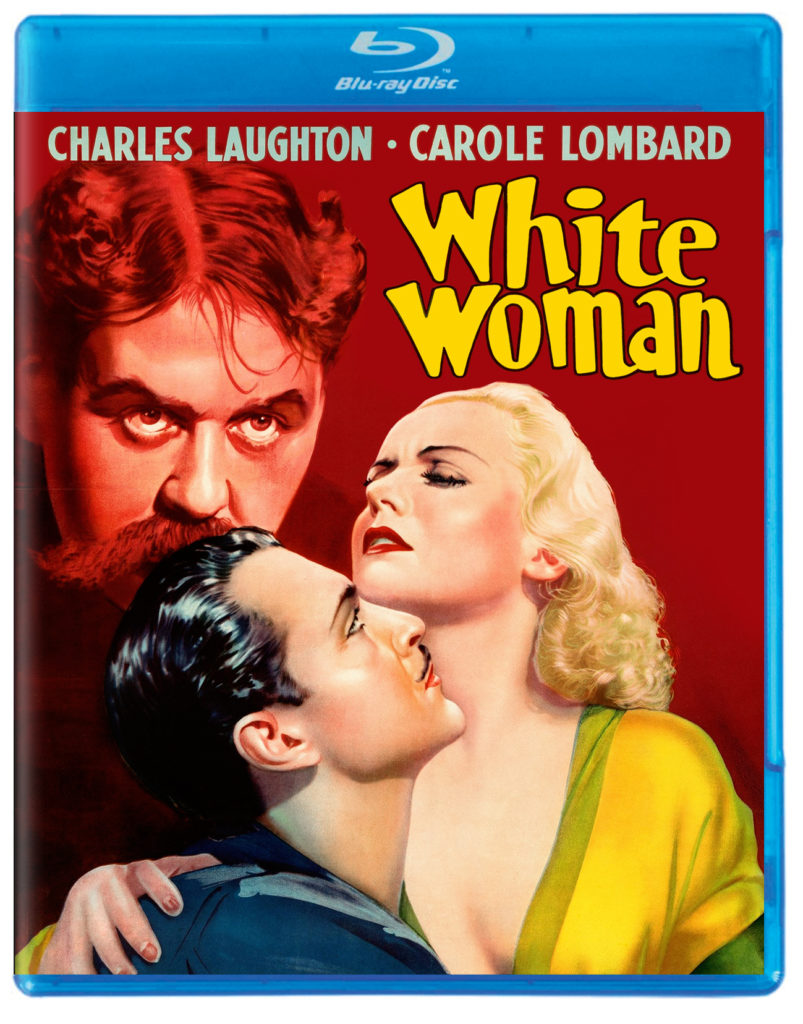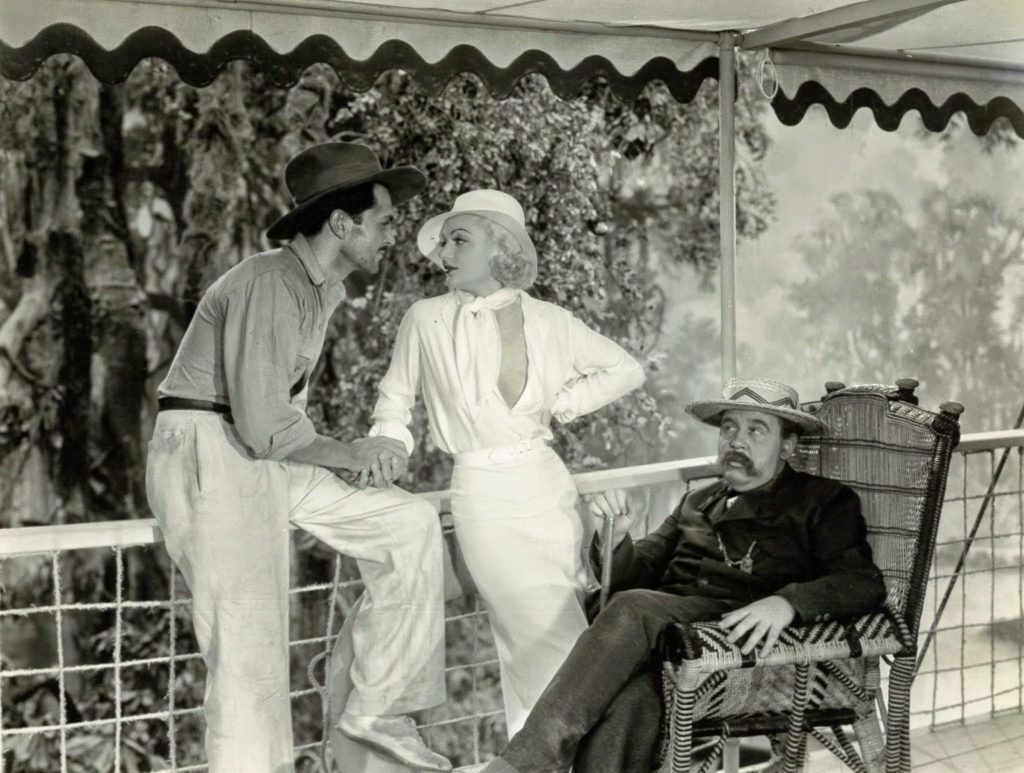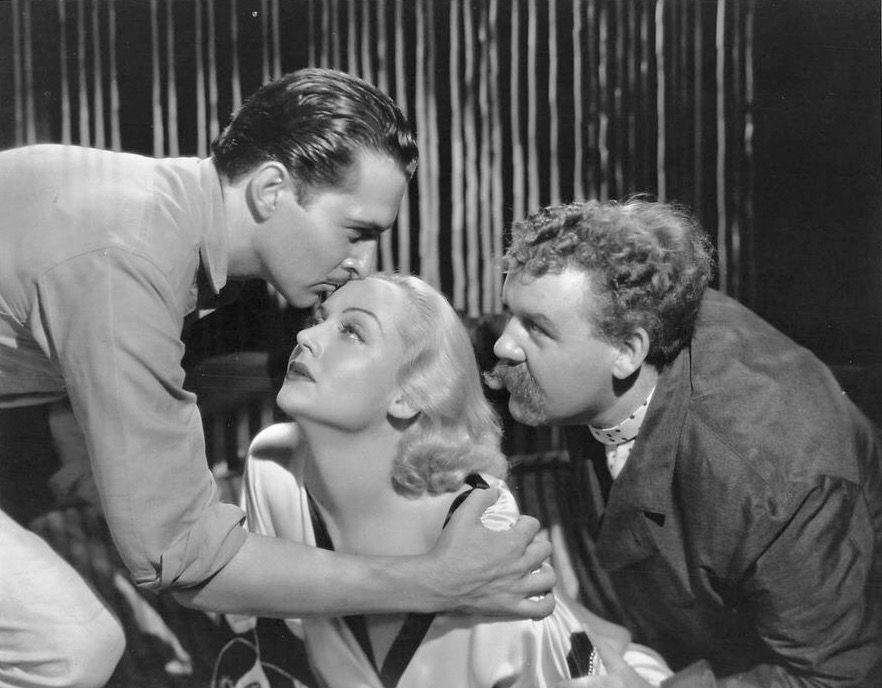Dubious Title Supports Preposterous Story In Leaden Pre-Code Melodrama

DIRECTED BY STUART WALKER
STREET DATE: FEBRUARY 14TH, 2023/KINO LORBER STUDIO CLASSICS
If you got past the title, I congratulate you. Kino Lorber Studio Classics unleashes Paramount Studios’ and director Stuart Walker’s exotic melodrama White Woman on Blu-ray this Valentine’s Day, proving love is never impossible to find no matter where you look for it. Even, I might add, on a cramped jungle set with an unrestrained British thespian performatively consuming every studio-created canopy-leaf, rubber-edged spear, and cyclorama-painted backdrop in screen-view. Charles Laughton, immediately coming off the success of The Private Life of Henry VIII (1933), and Carole Lombard, one year before inaugurating the screwball comedy in Howard Hawks’ Twentieth Century (1934), enact possessive on his part, indifferent on hers, anti-romantic movie-love to the advantage of neither, in 68 minutes of simmering colonial stew that an no point comes to a story-boil. Like its title, White Woman fails to evoke much more than risibility in terms of its story, characters, and execution.

Lombard is a scandalous social outcast surviving as a torch-singing chanteuse in a native-owned nightclub as the film opens. Set, we are told, in Malaysia, the cream-colored suits here slumming and the tray-carrying mess-jackets here serving mark the smoke-shrouded and fan-swirling, shadowy atmosphere with as undifferentiated mise-en-scene as contemporary movie-stories set in Shanghai, Brazil, North Africa, Central Asia; or indeed any other then-contentious, developing, and therefore drama-exploitable points on the globe. Into the sultry, mysterious gloom, unobtrusively at first, and with his back to the camera, no less, enters Laughton’s rubber plantation-owner, whose dropped ‘h’-s and ‘r’-s mark the portly, handle-bar mustachioed figure as a powerful man of humble origins.
A man who knows what he wants and wants what he sees! And a woman who takes what she can get. Soon, both are approaching Laughton’s steamship houseboat on the river, where, whatever the questionable arrangement between them, any unromantically misty “understanding” soon evaporates as Laughton dresses down, and Lombard dresses up to, the visibly salivating, variously disgraced Western exiles in their employ. Among these is a leaner, better-mustachioed German ex-aristocrat played by the otherwise unremarkable Kent Taylor, who Lombard quickly comes to see as her best means of escape off this sordid peninsula.
But shrewd and unscrupulous Laughton is ahead of them, and systematically arranges for the removal by “accident” of his sexually more interesting male employees; while the least threatening of them, played by future “Pa Kettle” Percy Kilbride as Laughton’s lackadaisical chef and manservant, provides comic relief with his talented and scene-stealing young chimpanzee assistant named “Duke”. Around this time, Charles Bickford as an aggressive, gruff American-type shows up to fill the masculine void left by Taylor. Who it turns out is not dead but only plotting to spirit Lombard away. At which Laughton, in a fit of off-screen jealousy at being upstaged by a primate, perhaps, seals his own fate by shooting the poor chimp and hurling its (hilariously unconvincing) corpse on the brig in front of slow-burning but now action-spurred Kilbride. All variously leave Laughton to his shipboard end with the growingly restless natives – even Bickford, soon left rigor-mortis grinning with an arrow through his neck, seems resigned to his fate – and the promise of seeing the colonialist’s corpse riddled with spears is unfortunately visually preempted by a degree of self-censorship rarely exercised in the pre-code era.
Too bad! “More pricked than pricking” might have proved a worthy visual epitaph for this psychotic cuckold, if the film had shown a degree of imagination or daring elsewhere, that is. As is, White Woman merely bakes its “exotic” mise-en-scene in over-glaring Klieg-wattage that seems to only dissipate the drama and enervate the characters. Leaving Laughton, facial contortions failing to curl the bushy ends of his walrus mustache, to display the mainly unmotivated screen histrionics that, devoid of stronger dramatic context, appear somewhat less effective than childish temper tantrums, and not the frightening fits of impotent rage probably intended.
Lombard fares little better, the over-lighting in the day-scenes nearly bleeding the physical outline of her title character into the background of her own listless maneuverings. Seemingly uninvolved in her own story, her character is left to more or less sleepwalk through potentially dangerous, physically threatening situations that nevertheless fail to raise the emotional temperature of the merely temporal progression of scenes, despite the apparent intensity of the jungle heat.
Or perhaps it’s just too damned hot to care? In any event, when our title White Woman disappears from the last reel of the film – already being led by the German aristo to safety up the river and back to “civilization”; Laughton’s attempted sabotage of the motor-skiff foiled by Kilbride’s de facto screen-revenge for gratuitous chimp-homicide – we register her absence only insofar that the now more vivid visuals of the plot-climactic native night-killing, shadows creeping silently up the ship, become more atmospherically interesting in their chiaroscuro effects than in the saturated lighting-effects displayed heretofore. But again, being visually denied Laughton’s presumably spectacular demise leaves the viewer merely staring at some pretty shadows in the end, as opposed to more directly witnessing the visual punctuation-point of the plot. A shame!
While Kino Lorber’s “Brand New 2K Master” of White Woman on Blu-ray is undoubtedly the best way to see this pre-code curio, this viewer felt the night-scenes a tad murkier – unwary viewers will of course be visually exposed to scantily-clad natives beating their drums in the fire-lit jungle-clearing – and the previously mentioned day-scenes slightly more overexposed than might have been originally projected, but the present transfer does get the stylistic and (cruder) thematic point across, such as it is. Also on point is the feature-length commentary from filmmaker Allan Arkush and filmmaker/historian Daniel Kremer, the former of whom analyzes the film in terms of its narrative shortcomings and especially in the overall (substantially) missed opportunities in terms of its (lacking) stylistic presentation. Comparing White Woman to its disfavor with contemporary Paramount-produced colonial romantic epics, particularly those more famously directed by Josef von Sternberg and starring Marlene Dietrich, whatever the now dubious politics behind “exoticizing” foreign locales in titles like Morocco (1930) and Shanghai Express (1932), one could scarcely fault these films for the artistry of their presentation, the emotional impact of their performances, or the overall intensity of their storytelling.
For my own comparison in viewing, I felt a much better presentation of similar material is found in MGM’s year-earlier production of Red Dust (1932). Also set on an Asian rubber plantation, in what was then known as Indochina, the drama is leavened by (intentional) comedy, and the trifecta of individually charismatic performances from Clark Gable, Mary Astor, and especially Jean Harlow stand out from rather than sink into their plyboards-and-tank-steaming, carpet-and-canopy recreated locale. Besides which, regarding the title of White Woman, as a veritable object of screen-display in a foreign setting, the latter film’s fundamental flaw is exposed by considering Carole Lombard as decidedly not fitting into the somewhat soiled peroxide bottled-blonde role that Harlow and other brash(er) pre-code females more effectively essayed. Uncomfortable race-associations and sex-references to one side, even, the screen-prototypical White Woman is simply not Lombard.

After watching this movie for academic interest, personal curiosity, or otherwise, and if in need of a Lombard movie palette-cleanser, more temperamentally-suitable screwball comedies for the actress were soon to follow, and films like My Man Godfrey (1936) and Nothing Sacred (1937) were much better for their producers simply getting out of her hair, here quite literally, and allowing Lombard to be herself; as opposed to wasting her irreducible talents on the racially, sexually, and emotionally imperiled woman of the movie-tropics. Those dames were a dime a dozen, but Lombard was one in a million.
Images in this review are used only as a visual reference to the film and do not reflect the quality of Kino Lorber’s Blu-ray.

